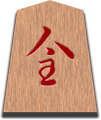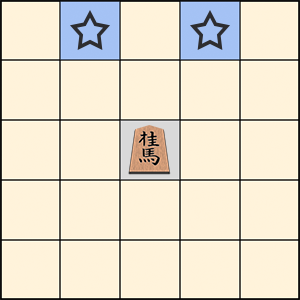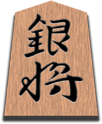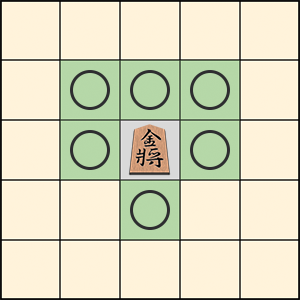Introduction
Shogi (将棋), or the "Game of Generals", is a Japanese variant of chess, and is the most popular traditional strategy game in Japan. Sharing many similarities with the more well-known Western chess, shogi is especially notable for introducing rules that allow players to return captured pieces to the board. This key difference means that a material advantage is less impactful, and trading a powerful piece for a weaker one may be more valuable. Because of this, the outcome of a game is more likely to be uncertain until the very end.
Shogi, along with chess, makruk, shatranj, and xiangqi, all evolved from the Indian game Chaturanga, which dates back to the 6th century. The current ruleset of shogi has existed since the 16th century, when the drop rules were introduced. Earlier versions of shogi have existed since at least the early 12th century, as described in the historical documents Shōchūreki (掌中歴) and Kaichūreki (懐中歴).
Setup
Players sit on opposite sides of a shogi board ("ban", 盤) comprised of 9 ranks (rows, 段) and 9 files (columns, 筋), resulting in an 81-space playing area. Unlike chess, color is not used to differentiate board spaces or pieces. Rather, the pieces have a pointed pentagonal shape which is aimed away from their owner. Players each have 20 pieces of varying sizes: 1 king, 1 rook, 1 bishop, 2 gold generals, 2 silver generals, 2 knights, 2 lances, and 9 pawns.
Next to the board on each player's right side is a stand ("komadai", 駒台) for captured pieces. In casual games where players do not have dedicated stands, half of the box containing the pieces may be flipped over and used instead.
Pieces are arranged in radial symmetry for the two players; that is, if the board is rotated 180 degrees, the pieces are arranged the same way. In the row closest to each player, that player places his king in the center, surrounded by two golden generals, followed by silver generals, knights, and finally, lances. In the second row, he places his bishop above the left knight and rook above the right knight. Finally, he fills the third row with pawns. This results in the following board state:

The first player is referred to as Sente (先手) or Black and the second player is referred to as Gote (後手) or White. Player order is determined by a piece toss, or furigoma (振り駒). One player collects his five central pawns and tosses them onto the board. Pieces that land on their side are tossed again. If the number of unpromoted pawns outnumbers the promoted pawns, the player who tossed the pieces is Sente.
After returning the tossed pawns to their starting positions, the game proceeds. Players take turns either moving pieces or dropping captured pieces until the end of the game.
Rules
Objective
As in chess, the goal of the game is to checkmate the opponent's king. This is done by using pieces to attack in such a way that the opponent has no valid moves that remove all threat to his king.
Movement
There are three kinds of movement in shogi: steps, jumps, and ranging. Step movement allows a piece only to move to an adjacent square, shown below by a green square with a circle in it. Jump movement allows a piece to move to a space regardless of obstacles that would otherwise block it, shown below by a blue square with a star. Range movement allows a piece to move any number of spaces in a specified direction until it reaches a friendly piece or captures an enemy piece. Range movement is shown below by red squares with arrows.
Most pieces, when promoted, change their movement options to that of a gold general, which itself cannot promote. The rook and bishop, however, instead add one step movement to the direction they can't move in. The pieces are shown below with their promoted versions in red.
| Image | English Name | Kanji | Romaji | Translation | Movement | Promoted Movement |


|
Pawn Promoted Pawn |
歩兵 と金 |
fuhyō tokin |
Foot Soldier Reaches Gold |
 |
 |


|
Lance Promoted Lance |
香車 成香 |
kyōsha narikyō |
Incense Chariot Promoted Incense |
 |
 |


|
Knight Promoted Knight |
桂馬 成桂 |
keima narikei |
Cassia Horse Promoted Cassia |
 |
 |


|
Silver General Promoted Silver |
銀將 成銀 |
ginshō narigin |
Silver General Promoted Silver |
 |
 |
 |
Gold General | 金將 | kinshō | Gold General |  |
N/A |


|
King (higher ranked player) King (challenger) |
王將 玉將 |
ōshō gyokushō |
King General Jeweled General |
 |
N/A |


|
Rook Promoted Rook |
飛車 龍王 |
hisha ryūō |
Flying Chariot Dragon King |
 |
 |


|
Bishop Promoted Bishop |
角行 龍馬 |
kakugyō ryūma |
Angle Mover Dragon Horse |
 |
 |
Capturing Pieces
When a piece is moved onto a space occupied by an opponent's piece, the opponent's piece is captured. The player then removes the captured piece from the board and places it on the piece stand on his side. If the piece was promoted when it was on the board, it is returned to its unpromoted state. This piece may later be used as a drop. Captured pieces are said to be "in hand".
Dropping Pieces
Instead of moving a piece already on the board, a player may instead use a captured piece by removing it from his piece stand and placing it on an open space on the board. A piece drop must adhere to the following restrictions:
- Two Pawns (nifu, 二歩): No column may contain two unpromoted pawns for any given player.
- Drop Pawn Mate (uchifudzume, 打ち歩詰め): A player may not checkmate his opponent with a pawn drop.
- No legal move: A dropped piece must be able to move on a future turn. For example, a pawn may not be dropped on the last row, as it would never be able to move in the future.
Any vacant space may be used for the piece drop as long as these rules are followed. All pieces are dropped in their unpromoted state, and may only promote after moving on a future turn, assuming they are eligible for promotion.
Drops are the driving force behind the complexity and excitement of a shogi game. Because pieces are never lost, unlike western chess, stalemates are exceedingly rare. There are also many situations where it may be more valuable to a player to trade for a lower-value piece so that they can use it as a drop in a subsequent attack.
Promotion
Most pieces in shogi are able to promote. While the gold general and king do not have promotions available, when any other piece enters or exits the enemy camp - defined as the furthest three rows from a player - that piece is then eligible to promote. To promote a piece, a player flips the piece over to its reverse side at the end of its movement, keeping their piece pointed at their opponent. This piece then remains promoted until captured or the end of the game.
In situations where a piece would no longer be able to move on any future turn, a promotion is forced. For example, if a lance advances to the last row, it must promote. This is done so that pieces always have valid movement.
Check
When a king is threatened by an opponent's piece, that king is in "check". The player controlling the king must use their next move to protect their king if they are able. This may be achieved by capturing the attacking piece, moving the king to a space where it would no longer be in danger, or, if the attacking piece is a ranging piece, by blocking its movement with a drop or other friendly piece.
It is not required to say "check" during a shogi game, though if players wish to do so, they may say "ōte" (王手). This is purely an influence from casual western chess players. Contrary to popular belief, western chess does not require one to say "check", either!
When a player is unable to make a move that would see his king to safety, he is checkmated and has lost the game.
Winning, Losing, and Ties
Typically, games end with a checkmate or resignation. Players may resign at any time if they feel their outlook is hopeless. This is frequently the case when a player realizes he's on the losing side of a tsume, a forced mate sequence. In these cases, one player is able to threaten the opposing king with every move until he has checkmated his opponent in a way that is not preventable. Players announce a resignation with the phrase "makemashita" (I lost, 負けました).
However, there are other situations which can arise. To prevent games from repeating moves indefinitely, the rule of repetition exists to force an end to the game. If a boardstate is repeated on any four separate occasions, the game is usually considered to be a draw. However, if one player is placed in perpetual check, the player giving check instead loses the game.
In amateur play, if both kings cross into their promotion zone, the game stops and each player is given a score. For each rook or bishop, players are awarded 5 points, and for all other non-king pieces are awarded 1 point each. This count includes pieces in-hand. A player scoring less than 24 points in this way loses the game. If both players have 24 or more points, the game is a draw. This is done to prevent a long, drawn-out game as kings that cross into the promotion zone are very difficult to mate or gain material advantages against.
Additionally, should a player make an illegal move at any point in the game, the game is an automatic loss for that player. This is true as long as the illegal move is noticed during the game, even if gameplay continued past the illegal move. However, if a match has ended and the error has not been noticed, the result of the game stands. Illegal moves may be:
- Dropping a piece where it would never have possible movement.
- Dropping a piece in its promoted state
- Two unpromoted pawns for one player in the same column (nifu)
- Checkmating an opponent with a pawn drop
- Moving a piece to a space that it cannot legally move to
- Making a second move on one turn, or playing first after losing the pawn toss
- Moving a king into check, or ignoring check
Of course, during casual play, and especially when teaching new players, it's perfectly fine to allow players to undo their moves for a teaching experience!
In tournament settings, timers may also be used. While much more generous than western chess, the same rule applies that should a player completely run out of time, he then loses the game. However, there is a short grace period, or byōyomi, once the ordinary time has expired. The byoyomi varies depending on match settings, but it grants a player a short, secondary timer that resets with every move. Should he fail to make a move once the byōyomi expires, the game ends in defeat.
In professional shogi games, draws are not recognized. Should two players end a game in a draw, they play a second game using their remaining match time and switch the starting turn order.
Handicaps
Handicaps may be used to give weaker players an advantage against stronger opponents. This is achieved by removing pieces from the game completely. Depending on the skill differential, a greater number of pieces may be removed. Typically, a one-piece handicap involves removing either the bishop or rook. A two-piece handicap removes both, a four-piece handicap also removes the two lances, a six-piece handicap removes both silver generals, and so on.
Large handicaps are typically only used to teaching shogi to new players, and whenever a handicap game is played, the pawn toss is skipped and the stronger player moves first.
Game Flow & Basic Strategy
Like western chess, shogi breaks down into three main components: an opening, a mid-game, and an endgame. In the opening, each player generally aims to build a castle for his king, preparing a defense against his opponent's future attacks. The mid-game consists of attempting to break through an opponent's defenses or gain material advantage and the endgame begins when one player's defenses have been sufficiently weakened.
Learning proper openings, or senpō (戦法), is essential to improving when first learning shogi. Once a player is able to recognize each piece and remember its movement, it's important to read up on common castles. Using a basic castle will help reinforce a player's understanding of how each piece interacts with others. While there are hundreds of possible formations, just starting with even one castle will be immensely helpful, as a player who does not have a decent defense in the opening will be overwhelmed easily.
For further improvement, players can counter openings with particularly recommended move sequences, known as jōseki (定跡). Jōseki frequently feature explanations for how to add pressure and attack or avoid blunders.
Manners & Proper Etiquette
Shogi is not just a game, but rather a form of Japanese art. As it is an important part of Japanese culture, players would do well to be courteous and respectful at all times. This applies not just to their opponent, but also the board, pieces, and the room it is played in.
Players should greet each other at the start of a game with the phrase "onegaishimasu" (お願いします), or to be more formal, "yoroshiku onegaishimasu" (よろしくお願いします), roughly translating to "let's have a good game". Additionally, when a player notices that loss is inevitable, he should announce his own defeat by saying "makemashita" (負けました), translating to "I lost".
Players should avoid touching pieces unless they intend to move it, and players should only make moves that are made with their best effort. Making moves that are intentionally bad is considered insulting.
Once the game is over, the players should review the game together, with the winning player leading the review. Discussion points should begin from the start of the game and include weaknesses in players' attacks and defenses, turning points, and blunders. Players should never boast or otherwise taunt the other player, instead maintaining respect and constructively identifying where the other might have missed an opportunity, helping each other improve. Afterwards, both players should thank each other for the game.
